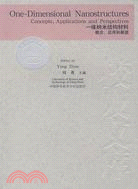一維納米結構材料概念.應用和展望(簡體書)
商品資訊
系列名:當代科學技術基礎理論與前沿問題研究叢書
ISBN13:9787312022012
出版社:中國科學技術大學出版社
作者:周勇
出版日:2009/07/01
裝訂/頁數:平裝/272頁
規格:26cm*19cm (高/寬)
版次:1
商品簡介
目次
相關商品
商品簡介
納米材料是20世紀80年代中期一個迅速發展的材料科學領域,受到人們廣泛的關注。本書選擇性的匯集了國內外中國科技大學校友在一維納米材料的最新科技研究成果。書中介紹了一維納米材料包括納米線、納米管和納米帶等當今研究的趨勢、相關技術與未來發展方向,是化學、物理和材料等學科的基礎理論研究與應用技術的前沿集成反映。
本書適合于高等學校、科研院所以及相關企業從事納米材料研發的科研人員和管理工作者,同時也可作為相關專業的師生和愛好者學習參考用書。
本書適合于高等學校、科研院所以及相關企業從事納米材料研發的科研人員和管理工作者,同時也可作為相關專業的師生和愛好者學習參考用書。
目次
Preface of Alumnis Serials
Preface
Chapter 1 Lipid Nanotubes and Peptide Nanotubes: Formation and Applications for Scaffolding Nanomaterials
Abstract
1.1 Introduction
1.2 Formation of LNTs
1.3 Formation of PNTs
1.4 Templating nanostructures
1.4.1 LNT-templating nanostructures
1.4.2 PNTs templating nanostructures
1.5 Conclusion
Acknowledgments
References
Chapter 2 Introduction of Nanodevices Based on ZnO Nanowires/Nanobelts
Abstract
2.1 Introduction
2.2 Transport properties of ZnO nanowires/nanobelts
2.2.1 Field effect transistor based on ZnO NWs
2.2.2 Schottky diodes based on ZnO NBs/NWs
2.3 Piezoelectronics based on ZnO NWs/ NBs
2.3.1 Piezoelectricity and structure of ZnO
2.3.2 Piezoelectric nanogenerators
2.4 Optoelectronics based on ZnO NWs
2.4.1 UV detector
2.4.2 Nanowire based nano]asers
2.4.3 Nanowire array LED
2.5 Chemical and biological sensors based on ZnO nanowires
2.6 Doping modification, field emission and mechanical properties
2.6.1 Metal doping of ZnO
2.6.2 Field emission properties of ZnO nanowire arrays
2.6.3 Nanobalance based on ZnO nanowire
2.7 Summary
References
Chapter 3 Elastic Properties of One-dimensional Metal Nanoparticles Studied by Time-resolved Spectroscopy
3.1 Introduction
3.1.1 Metal nanoparticles
3.1.2 Time-resolved spectroscopy
3.2 Theory
3.3 Experimental apparatus and techniques
3.3.1 Synthesis of au nanorods
3.3.2 Transient absorption apparatus
3.4 Experimental results
3.4.1 Characterization of au nanorods
3.4.2 Transient absorption experiment
3.4.3 Elastic properties of gold nanorods
3.4.4 Discussion of the elastic moduli of metal nanorods
3.5 Summary and conclusion
Acknowledgment
References
Chapter 4 Microwave-assisted Rapid Preparation of One-dimensional Nanostructures
Abstract
4.1 Microwave-assisted ionic liquid (MAIL) method
4.1.1 Preparation of elemental 1-D nanostructures
4.1.2 Preparation of 1-D nanostructures of metal oxides
4.1.3 Preparation of metal chalcogenide 1-D nanostructures
4.1.4 Preparation of nanostructures with other morphologies
4.2 Microwave-assisted polythiol reduction (MPTR) method
4.3 Microwave-assisted polyol method
4.4 Microwave-assisted polyol-water method
4.5 Microwave-assisted aqueous solution method
References
Chapter 5 Some Recent Developments in the Solution-Phase Synthesis of One-Dimensional Inorganic Nanostructures
Abstract
5.1 Introduction
5.2 Coordination compounds, structural characteristics to direct anisotropic growth
5.2.1 Simple complexes
5.2.2 Linear coordination cluster compounds
5.2.3 Metal-polymer coordination chains
5.2.4 3-D coordination polymers
5.3 Surfactant-based systems: microreactors to confine anisotropic growth
5.3.1 Rod-like micelles
5.3.2 Inorganic-surfactant intercalated mesostructures
5.4 Etching and twinning: two contributions to induce anisotropic growth
5.4.1 Localized oxidative etching on single-crystal seeds
5.4.2 Twin defects to break cubic symmetry
5.5 Concluding remarks
Acknowledgements
References
Chapter 6 One-Dimensional Nanoscale Heterostruetures
Abstract
6.1 Introduction
6.2 Synthetic routes for 1 - D nanoscale heterostructures
6.2.1 Vapor phase methods
6.2.2 Solution methods
6.2.3 Lithography
6.2.4 Electrospinning
6.2.5 Template directed methods
6.3 Typical 1 - D nanoscale heterostructures
6.3.1 Co-axial nanowires
6.3.2 Segmented nanowires
6.4 Oonclusion and remarks
References
Chapter 7 Bid Meets Nano: DNA-Based Synthesis and Assembly Toward One-Dimensional Nanostructures
7.1 Introduction
7.2 DNA templated electroless deposition for metallic nanowire fabrications
7.3 DNA directed assembly of nanoparticle linear arrays
7.3.1 DNA encoded one-dimensional array of gold nanoparticles
7.3.2 RCA facilitated assembly of long, sturdy and rigid DAEE array suitable for protein organization
7.4 One dimensional self-assembly on DNA-wrapped carbon nanotub
7.5 DNA nanotubes, constructions and functionalizations
7.6 Other examples of DNA-based one dimensional nanostructures
7.7 Outlook
Acknowledgements
References
Chapter 8 Soft Chemistry Routes to Synthesis of One-Dimensional Nanostructures and Their Properties
8.1 Introduction
8.2 Rare earth compound 1-D nanostructures
8.3 1-D nanostructures templated by organic additives
8.4 Biomimetic synthesis of 1-D nanostructures
8.5 Other functional 1-D nanostructured materials
8.6 The formation mechanism of 1-D nanostructures
8.7 Summary and outlook
Acknowledgement
References
Preface
Chapter 1 Lipid Nanotubes and Peptide Nanotubes: Formation and Applications for Scaffolding Nanomaterials
Abstract
1.1 Introduction
1.2 Formation of LNTs
1.3 Formation of PNTs
1.4 Templating nanostructures
1.4.1 LNT-templating nanostructures
1.4.2 PNTs templating nanostructures
1.5 Conclusion
Acknowledgments
References
Chapter 2 Introduction of Nanodevices Based on ZnO Nanowires/Nanobelts
Abstract
2.1 Introduction
2.2 Transport properties of ZnO nanowires/nanobelts
2.2.1 Field effect transistor based on ZnO NWs
2.2.2 Schottky diodes based on ZnO NBs/NWs
2.3 Piezoelectronics based on ZnO NWs/ NBs
2.3.1 Piezoelectricity and structure of ZnO
2.3.2 Piezoelectric nanogenerators
2.4 Optoelectronics based on ZnO NWs
2.4.1 UV detector
2.4.2 Nanowire based nano]asers
2.4.3 Nanowire array LED
2.5 Chemical and biological sensors based on ZnO nanowires
2.6 Doping modification, field emission and mechanical properties
2.6.1 Metal doping of ZnO
2.6.2 Field emission properties of ZnO nanowire arrays
2.6.3 Nanobalance based on ZnO nanowire
2.7 Summary
References
Chapter 3 Elastic Properties of One-dimensional Metal Nanoparticles Studied by Time-resolved Spectroscopy
3.1 Introduction
3.1.1 Metal nanoparticles
3.1.2 Time-resolved spectroscopy
3.2 Theory
3.3 Experimental apparatus and techniques
3.3.1 Synthesis of au nanorods
3.3.2 Transient absorption apparatus
3.4 Experimental results
3.4.1 Characterization of au nanorods
3.4.2 Transient absorption experiment
3.4.3 Elastic properties of gold nanorods
3.4.4 Discussion of the elastic moduli of metal nanorods
3.5 Summary and conclusion
Acknowledgment
References
Chapter 4 Microwave-assisted Rapid Preparation of One-dimensional Nanostructures
Abstract
4.1 Microwave-assisted ionic liquid (MAIL) method
4.1.1 Preparation of elemental 1-D nanostructures
4.1.2 Preparation of 1-D nanostructures of metal oxides
4.1.3 Preparation of metal chalcogenide 1-D nanostructures
4.1.4 Preparation of nanostructures with other morphologies
4.2 Microwave-assisted polythiol reduction (MPTR) method
4.3 Microwave-assisted polyol method
4.4 Microwave-assisted polyol-water method
4.5 Microwave-assisted aqueous solution method
References
Chapter 5 Some Recent Developments in the Solution-Phase Synthesis of One-Dimensional Inorganic Nanostructures
Abstract
5.1 Introduction
5.2 Coordination compounds, structural characteristics to direct anisotropic growth
5.2.1 Simple complexes
5.2.2 Linear coordination cluster compounds
5.2.3 Metal-polymer coordination chains
5.2.4 3-D coordination polymers
5.3 Surfactant-based systems: microreactors to confine anisotropic growth
5.3.1 Rod-like micelles
5.3.2 Inorganic-surfactant intercalated mesostructures
5.4 Etching and twinning: two contributions to induce anisotropic growth
5.4.1 Localized oxidative etching on single-crystal seeds
5.4.2 Twin defects to break cubic symmetry
5.5 Concluding remarks
Acknowledgements
References
Chapter 6 One-Dimensional Nanoscale Heterostruetures
Abstract
6.1 Introduction
6.2 Synthetic routes for 1 - D nanoscale heterostructures
6.2.1 Vapor phase methods
6.2.2 Solution methods
6.2.3 Lithography
6.2.4 Electrospinning
6.2.5 Template directed methods
6.3 Typical 1 - D nanoscale heterostructures
6.3.1 Co-axial nanowires
6.3.2 Segmented nanowires
6.4 Oonclusion and remarks
References
Chapter 7 Bid Meets Nano: DNA-Based Synthesis and Assembly Toward One-Dimensional Nanostructures
7.1 Introduction
7.2 DNA templated electroless deposition for metallic nanowire fabrications
7.3 DNA directed assembly of nanoparticle linear arrays
7.3.1 DNA encoded one-dimensional array of gold nanoparticles
7.3.2 RCA facilitated assembly of long, sturdy and rigid DAEE array suitable for protein organization
7.4 One dimensional self-assembly on DNA-wrapped carbon nanotub
7.5 DNA nanotubes, constructions and functionalizations
7.6 Other examples of DNA-based one dimensional nanostructures
7.7 Outlook
Acknowledgements
References
Chapter 8 Soft Chemistry Routes to Synthesis of One-Dimensional Nanostructures and Their Properties
8.1 Introduction
8.2 Rare earth compound 1-D nanostructures
8.3 1-D nanostructures templated by organic additives
8.4 Biomimetic synthesis of 1-D nanostructures
8.5 Other functional 1-D nanostructured materials
8.6 The formation mechanism of 1-D nanostructures
8.7 Summary and outlook
Acknowledgement
References
主題書展
更多
主題書展
更多書展今日66折
您曾經瀏覽過的商品
購物須知
大陸出版品因裝訂品質及貨運條件與台灣出版品落差甚大,除封面破損、內頁脫落等較嚴重的狀態,其餘商品將正常出貨。
特別提醒:部分書籍附贈之內容(如音頻mp3或影片dvd等)已無實體光碟提供,需以QR CODE 連結至當地網站註冊“並通過驗證程序”,方可下載使用。
無現貨庫存之簡體書,將向海外調貨:
海外有庫存之書籍,等候約45個工作天;
海外無庫存之書籍,平均作業時間約60個工作天,然不保證確定可調到貨,尚請見諒。
為了保護您的權益,「三民網路書店」提供會員七日商品鑑賞期(收到商品為起始日)。
若要辦理退貨,請在商品鑑賞期內寄回,且商品必須是全新狀態與完整包裝(商品、附件、發票、隨貨贈品等)否則恕不接受退貨。
























